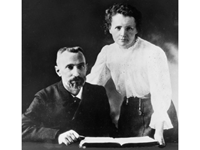The Miller–Urey Experiment (or Urey–Miller Experiment) was a study conducted in 1952 to test the chemical evolution process, in which the conditions of the early Earth were replicated in a laboratory according to the scientific understanding of the time. This experiment was designed to test the hypothesis proposed by Aleksandr Ivanovich Oparin and J.B.S. Haldane that inorganic substances found on the early Earth could be converted into organic compounds through chemical reactions. Recognized as a classic experiment in abiogenesis research, the study was conducted in 1952 by Stanley Lloyd Miller and Harold Urey at the University of Chicago.
Reanalysis conducted in October 2008 revealed that the number of amino acids produced in this experiment was greater than previously thought; while initially five amino acids were detected, it was later understood that 22 different amino acids had actually been formed. It is believed that the experimental setup mimicked an environment similar to volcanic eruptions accompanied by lightning. These findings provide strong evidence that organic molecules can be synthesized spontaneously from inorganic materials. Although subsequent research has shown that Earth's early atmosphere may have differed from the gas mixture used in the Miller experiment, prebiotic experiments conducted under various conditions can still produce racemic mixtures of various compounds (such as cyanide) ranging from simple to complex.
Miller and Urey conducted their experiments using water (H₂O), methane (CH₄), ammonia (NH₃), hydrogen (H₂), and carbon monoxide (CO). These substances were contained in a closed system consisting of sterile glass tubes and containers that did not come into contact with the outside environment. One glass container in the system was half-filled with water, while the other contained two electrodes that produced an electric spark. The water was heated and vaporized, and when the vapor reached the gas mixture, a spark was generated between the electrodes, mimicking the lightning effect on the primitive Earth. The gases were then cooled and returned to a liquid state, dripping back into the water container. This cycle continued continuously.
After about a week of work, it was observed that 10-15% of the carbon in the system had been converted into organic compounds. Approximately 2% of the carbon had been converted into amino acids, with glycine being the most abundant. Additionally, sugars, fats (lipids), and some building blocks of nucleic acids had also formed.
In an interview, Stanley Miller stated, “Even producing a spark in a simple prebiotic experiment creates 11 of the 20 amino acids.” In the experiments, as in subsequent studies, a “racemic” mixture containing both right- and left-handed forms of amino acids was obtained.
The Miller–Urey experiment inspired many other studies. In 1963, Joan Oró obtained amino acids from hydrogen cyanide (HCN) and ammonia in water. In his experiment, he also observed that large amounts of adenine, one of the building blocks of DNA and RNA, were formed. Subsequent research showed that other DNA and RNA bases could also be synthetically produced under reducing atmospheric conditions.
During the years when the Miller–Urey experiment was conducted, there were other electrical discharge experiments related to the origin of life. For example, an article published in The New York Times on March 8, 1953, described the work of William M. MacNevin from Ohio State University. MacNevin had produced “solid resins” by passing 100,000-volt sparks through methane and water vapor. However, it is unknown whether he published these results in a scientific paper.
Similarly, K. A. Wilde, in a study submitted to Science magazine on December 15, 1952, obtained a small amount of carbon monoxide by applying 600 volts of electricity to a mixture of carbon dioxide (CO₂) and water (H₂O). However, no other significant compounds were formed.
More recently, Jeffrey Bada replicated Miller's experiment. According to current models, the early Earth's atmosphere was rich in carbon dioxide and nitrogen (N₂). Under these conditions, nitrites formed and amino acids broke down as soon as they were produced. When Bada added iron and carbonate minerals to his experiment to reduce this effect, he obtained richer amino acids. This demonstrated that amino acids could form even in an atmosphere dominated by carbon dioxide and nitrogen.
Another study conducted in 2006 suggested that early Earth may have been covered by an organic haze. This haze, formed in an atmosphere with high concentrations of methane and carbon dioxide, is thought to have played a role in the emergence of life by transporting organic molecules across the entire surface of the Earth.
The chemistry of the experiment
It is known that in the first step of the reaction mixture, hydrogen cyanide (HCN), formaldehyde, and active intermediate compounds (acetylene, cyanoacetylene, etc.) are formed:
CO2 → CO + [O] (atomic oxygen)
CH4 + 2[O] → CH2O + H2O
CO + NH3 → HCN + H2O
CH4 + NH3 → HCN + 3H2 (BMA process)
These compounds then react with amino acid formations and other biomolecules (Stecker synthesis).
CH₂O + HCN + NH₃ → NH₂-CH₂-CN + H₂O
NH₂-CH₂-CN + 2H₂O → NH₃ + NH₂-CH₂-COOH
Some evidence regarding the early Earth's atmosphere suggests that the reducing gases used in the Miller-Urey experiment were less abundant than previously thought. Approximately 4 billion years ago, large volcanic eruptions released gases such as carbon dioxide (CO₂), nitrogen (N₂), hydrogen sulfide (H₂S), and sulfur dioxide (SO₂) into the atmosphere. Experiments using these gases in combination with those used in the Miller-Urey experiment yielded different results. In these experiments, racemic mixtures containing both L and D enantiomers were formed; both types can appear in the laboratory. However, L-type amino acids are more common in nature. Subsequent experiments have shown that L and D enantiomers can form in unequal proportions.
It was once thought that the atmosphere was mostly composed of ammonia (NH₃) and methane (CH₄). However, most of the carbon was in the form of carbon dioxide (CO₂) and carbon monoxide (CO), and nitrogen (N₂) was also abundant. There was no oxygen (O₂). Gas mixtures containing CO, CO₂, and N₂ can produce similar products to those produced by mixtures of methane and ammonia, provided that oxygen is absent. Most hydrogen atoms come from water vapor. Hydrogen-poor gas mixtures are necessary for the formation of aromatic amino acids under primitive Earth conditions. In various versions of the Miller experiments, amino acids, hydroxy acids, purines, pyrimidines, and some sugars have been successfully produced.
In 2005, the Universities of Waterloo and Colorado stated that their models showed that the early atmosphere contained up to 40% hydrogen and created an environment suitable for the formation of prebiotic organic molecules. When temperature estimates in the upper layers of the atmosphere were reevaluated, it was found that the amount of hydrogen escaping into space was much less than previously thought. Researcher Owen Toon states, “In this new model, organic compounds are produced efficiently. This brings us back to the idea of an organic-rich ocean soup.” Gas escape calculations based on the chondrite model also support these results, reinvigorating the Miller-Urey experiment.
However, when oxygen is added to the atmosphere in gaseous form, organic molecule formation stops. Critics of the Miller-Urey hypothesis have pointed to the presence of dissolved oxygen traces in uranium deposits dating back 3.7 billion years as evidence of the hypothesis's invalidity. However, the authors of the article argue that oxygen indicates the presence of photosynthetic organisms and that this date could push back the period in which the Miller-Urey experiments and abiogenesis occurred. Additionally, it is thought that the oxygen concentration in the atmosphere was very low (less than 0.1%) and that it was the same age as the oldest rocks. The authors note that oxygenic photosynthesis in the early period did not contradict the oxygen-free atmosphere.
Similar conditions to the Miller-Urey experiment are observed in other regions of the Solar System. Here, ultraviolet (UV) radiation initiates chemical reactions instead of electrical sparks. In 1969, the Murchison meteorite that fell in the Murchison region of Australia was found to contain over 90 different amino acids, 19 of which are present in life on Earth. Complex carbon compounds (such as tolin) formed by the effect of ultraviolet light are found on the surfaces of comets and other solar system objects. The early Earth was bombarded by comets filled with such complex organic molecules, water, and other volatile substances.


 Nielawore
Nielawore










Yorumlar
nice
Yorum yazmak için lütfen giriş yapınız